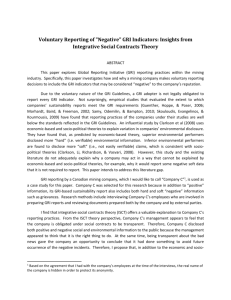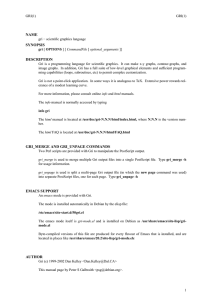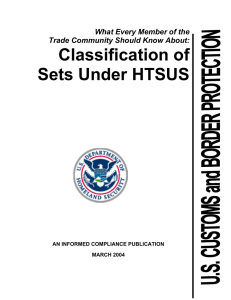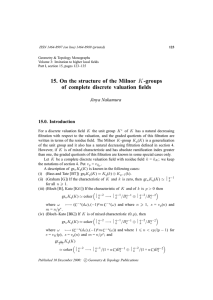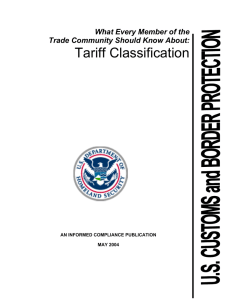Imports, Customs and Tariff Laws
advertisement
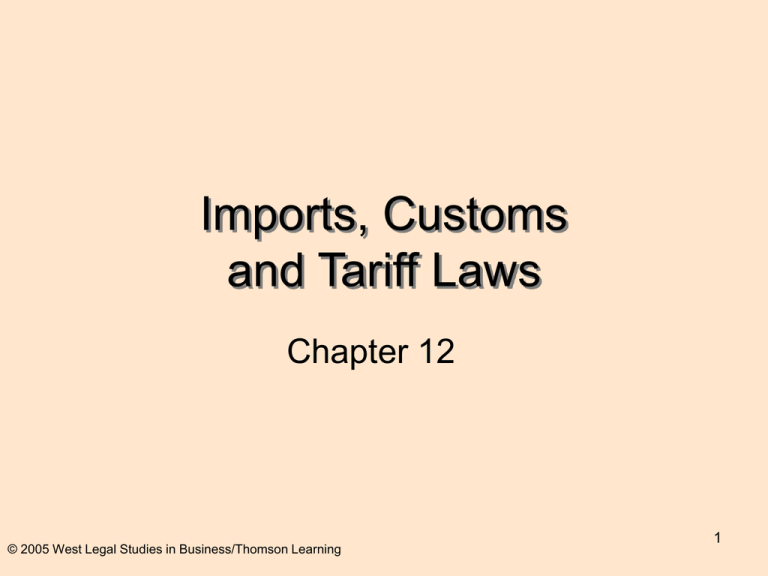
Imports, Customs and Tariff Laws Chapter 12 © 2005 West Legal Studies in Business/Thomson Learning 1 Entry Process • Customs and Border Protection department under Dept. of Homeland Security • Documents filed within 10 days • Pay duties • Electronic filing 2 Entry Process • Request binding ruling • Liquidation- final computation and payment of duty, within one year of entry • Protest within 90 days • Judicial review within 180 days (CIT in NYC) 3 Electronic Entry Processing • Automated • File electronically • Remote location 4 Enforcement and Penalties • Materially false statements – Negligent- U.S. v. Golden Ship Trading – Gross negligence “ actual knowledge or reckless disregard” 5 Penalties • Civil fraud: clear and convincing, knowingly made materially false statements or omissions (goods can be seized, penalties up to the value of the merchandise) • Criminal Fraud: 2 years plus fine • Smuggling of certain items will carry longer penalties • Better to disclose before investigation 6 Aggravating factors • Obstruction, withholding evidence, providing misleading information, prior improper shipments, illegal transshipments 7 Mitigating Factors • • • • • • • Errors by Customs Cooperation Immediate remedial action Inexperience Prior good record Inability to pay penalty Encouraged to report errors through PRIOR DISCLOSURE 8 Mitigating Factors • Statute of limitations: 5 years from the date of the violation • Or 5 years from the date of discovery of a violation involving fraud 9 Binding Rulings • Requesting one can help plan business strategy 10 Judicial Review • Judicial review of formal rulemaking • Judicial review of binding rulings, see U.S. v Mead • Pre-Importation Judicial review in emergency situations 11 How to classify goods? Ask for binding ruling or ruling letter. • Harmonized Tariff schedule of U.S. 1989 called the Harmonized Code • Special schedules in NAFTA agreement • Camel case: how to classify a tent? • Mead Diary case • Classification, value country of origin 12 How to classify goods? Ask for binding ruling or ruling letter. • Classification by name , physical characteristics and principal use • May also be classified by actual use 13 General Rules of Interpretation • Headings are only guides • Article described includes the completed finished product as well as the uncompleted if it has the character of the completed product • Specificity/ essential character • If does not fit, should go into the same category as a similar item • Last in numerical order 14 General Rules of Interpretation • • • • EO nominee- common name Physical characteristics Article’s use Common popular over commercial meaning • Use most specific • Essential character controls • All else equal, last in numerical order 15 General Rules of Interpretation: GRI • GRI 1: classification by terms of the headings • GRI 2: classification includes complete as well as incomplete article if it has the essential character • GRI 3: when goods could be classified under 2 headings – Go to the most specific, if components go to essential character, when can’t be classified by above go to the last in numerical order 16 General Rules of Interpretation: GRI • GRI 4: If goods can not be classified based on above, one should find heading for goods they are most like • GRI 5: a) cases (camera, music) should be entered with the article normally sold with b) packing goods shall be classified with the goods, unless containers have repetitive use • GRI 6: subheadings at the same level are comparable 17 Examples of rules applications • Relative specificity: stereo cabinet case • Essential character: Better Home Plastics, essential character not relative specificity applies, goods are classified by shower liner not curtain • An importer is free to engineer his product in order to take advantage of the tariff laws (Tariff engineering) 18 Customs Valuation • Dutiable value equals transaction value or price actually paid for goods when sold for export plus packing costs, selling commission paid by buyer, value of an assist, royalty buyer is responsible to pay, proceeds of any resale that accrues to buyer. • It does not include freight charges, insurance/broker’s fee, inland freight, assembly fees or import duties. 19 Relevance of Country of Origin? • Very important in NAFTA • Substantial transformation? Ferrostaal Metals v. U.S. • Name, character or use test • NAFTA tariff shift rule • Trade preference rules • Textile and apparel rules of origin • WTO rules- under development 20 GSP: Generalized System of Preferences • • • • Beneficiaries are developing countries Goods enter at lower tariff rate 1976 program- benefits 140 countries In 1980’s 4 countries graduated: Hong Kong, Singapore, S.Korea & Taiwan • GSP rules of origin-35% value added in GSP country 21 Marketing and Labeling of Imports • U.S. Customs • FTC- if states Made in USA means, “all or virtually all of the materials, processing or component parts are made in the U.S. and that their final assembly or processing took place there” • Only negligible foreign content- all or virtually all is a very high standard 22 Caribbean Basin Economic Recovery Act (1983) • Encourages manufacturing in Caribbean • The goods are imported to U.S. at favorable tariff rate • 2000 Caribbean Basin Trade Partnership Act: increased benefits 23 Africa Growth and Opportunity Act • 2000 • GSP through 2008 24 FTZ: Foreign Trade Zones • Goods may be imported without being subjected to tariffs until goods are released into the stream of commerce • Nissan v. U.S 25 Business Implications • Margin may be ruined by adverse Customs ruling • Thus, planning is essential • Knowledge of appropriate classification and entry process • Stay current with agreements like NAFTA which may affect your company’s products 26





